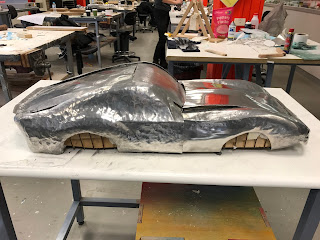Creating Waffles
As a group, we started off by deciding on creating the car using interlocking waffle slices in Slicer for Fusion 360.
As we played around with the settings, and with the help of tutors, we were able to decide that it would be better to have more slices as it was able to give a better representation of the Ferrari 250 GTO. This gave us a more detailed model of the car as the signature Ferrari curves and overall shape was more prominent.
Assembling the Waffle
The waffle slices were laser cut on MDF boards and assembled by interlocking each piece into the corresponding slot.
As we were assembling our model, we discovered that we didn't account for an allowance for the board thickness within the slots. We also realised that the large number of pieces made it difficult to assemble the car as each piece was pushing against each other. This made it difficult to slot the pieces together by hand as it was becoming too tight. As a result, we used a mallet to give each piece the final push into the correct position. All these missed considerations contributed to the struggle we faced during this assembly.
*Lesson to take away from this experience: Test things out before committing! In order to prevent this from happening, we should have started off by cutting a few pieces then see how they feel slotting together. Then alter the file in order to accommodate to the change.
Dividing Car into Parts
As a group, we covered the surface of the waffled Ferrari in masking tape in order to better visualise the curves that make up the car as a whole.
From this stage we were able to section off the car by marking out parts over the masking tape. This helped us in deciding how to distribute the car between the team. We then decided on who wanted to work on what parts each member of the group would be responsible for.
I chose to work on the bonnet as well as the front bumper. Celina and Nobel chose to work on the sides on the front end of the car. Esther and Vince on the sides at the rear. Yune chose the rear and top of the car including the windshield.
The Making of the Bonnet
We each created a template by tracing our chosen part on some tracing paper.
The next stage was to then mark our templates onto our aluminium pieces while marking out the piece around 10mm bigger than the template. Leaving some extra space around the perimeter allowed for room for error. I then cut the piece out using tin snips. I also took down some measurements for the dimensions of the detailing on the bonnet in order to help me to precisely replicate the model. These dimensions were then marked onto the inside of the piece in order to guide me in hammering in the correct location.
I started my piece off by hammering out the vertical detailing on the bonnet using the pointy end of the mallet. However, I was not able to achieve a clean indentation.
I then created a timber tool in order to define the detailing. This allowed me to make a more precise indentation.
It was also important to keep going back to the car and comparing my piece to the original part. This allowed me to make sure I was hammering the correct sections. By gradually hammering out the detailing and continually checking against the model, I was able to make sure that I didn't over hammer that particular section.
I then used the English Wheel to roll out the curve of the bonnet. This allowed me to achieve a smooth equal curve throughout the surface of the piece.
I started off the front bumper by hammering down the end piece using the rounded end of the mallet until it was curved over to my satisfaction.
The first assemblage of our car with the parts of each group member.
I created the grill by using the same timber tool used for the previous sections. I was able to place the grill in the correct position by following the markings I measured out at the beginning. I also kept referring back to the model car as I gradually hammered the piece to make sure I was on the right track.
I also used the tool in order to create the grill detailing by hammering out a vertical pattern on the inner surface of the front bumper.
I then used tin snips to trim the excess edges of my piece.
I then defined the detailing by hammering the pattern along the outer surface of the bumper.
The final stage was to polish my piece using Brasso in order to make it shiny and more presentable.





































No comments:
Post a Comment